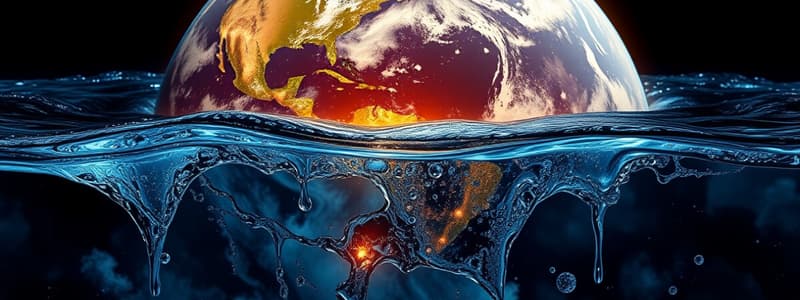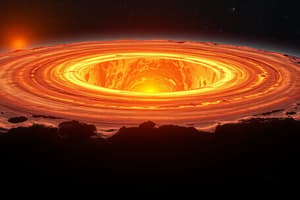Podcast
Questions and Answers
How was the Earth formed according to the accretion hypothesis?
How was the Earth formed according to the accretion hypothesis?
The Earth was formed through a process where gravity attracted tiny bits of matter, leading to the formation of planetesimals and eventually protoplanets.
What is the difference between homogeneous and heterogeneous accretion?
What is the difference between homogeneous and heterogeneous accretion?
Homogeneous accretion occurs from materials of the same composition, while heterogeneous accretion involves materials of different compositions.
Why is water considered the medium of life?
Why is water considered the medium of life?
Water is essential for all known forms of life, as it supports biological processes and is crucial for cellular function.
What are the primary sources of Earth's water?
What are the primary sources of Earth's water?
What percent of Earth’s water is freshwater?
What percent of Earth’s water is freshwater?
What is the significance of the Sun for life on Earth?
What is the significance of the Sun for life on Earth?
What does Earth's energy budget refer to?
What does Earth's energy budget refer to?
Which gases primarily make up Earth's atmosphere?
Which gases primarily make up Earth's atmosphere?
What is the coldest layer of the atmosphere?
What is the coldest layer of the atmosphere?
The exosphere is the closest layer to Earth.
The exosphere is the closest layer to Earth.
Match the following layers of the atmosphere with their characteristics:
Match the following layers of the atmosphere with their characteristics:
Flashcards are hidden until you start studying
Study Notes
Formation of Earth
- Accretion hypothesis explains Earth’s formation via gravity attracting matter.
- Process starts with the formation of planetesimals, which combine to create protoplanets.
- Homogeneous accretion refers to Earth forming from materials of the same composition post-condensation.
- Heterogeneous accretion involves materials of varied compositions during formation, leading to a differentiated planet.
- Homogeneous accretion's weaknesses include inability to explain the abundance of certain elements in the mantle.
- Heterogeneous accretion's challenges include the required rapid accretion rate and inconsistencies with observed planetary compositions.
Water: The Medium of Life
- Hydrosphere encompasses all water on Earth, divided into saltwater (97.5%) and freshwater (2.5%).
- Freshwater is vital for life and has negligible salt content compared to saltwater.
- Water's maximum density occurs at 3.98°C, contributing to habitat stability.
- Water is hypothesized to originate from comet collisions or could have been trapped within Earth as volatiles during magma formation.
Sun as the Main Source of Energy
- The Sun provides the necessary energy for processes on Earth, including supporting photosynthesis in plants.
- Albedo affects how much solar energy is absorbed or reflected; values range from 0 to 1.
- Earth’s energy budget consists of the balance between energy absorbed from the Sun and energy reflected, with about 30% reflected.
- Factors influencing Earth’s energy budget include surface color, radiation received, axial tilt, and greenhouse gas presence.
- The greenhouse effect plays a significant role in regulating the planet's temperature.
Earth’s Atmosphere
- Earth’s atmosphere consists primarily of nitrogen (78%) and oxygen (21%), with argon (0.9%) and trace gases (0.1%) in minor amounts.
- The atmosphere has five major layers: troposphere, stratosphere, mesosphere, thermosphere, and exosphere.
- Troposphere is the lowest layer where human activity and biosphere predominantly exist; thickness varies from 5 to 9 miles.
- Stratosphere, about 35 km thick, houses the protective ozone layer which absorbs UV radiation.
- Mesosphere is where meteorites disintegrate, characterized by extreme cold temperatures.
- Thermosphere can reach 1500°C and extends approximately 600 km; it's a layer of high temperatures.
- Exosphere, the outermost layer extending about 10,000 km, interfaces with outer space.
- The atmosphere plays a crucial role in the hydrologic cycle, acting as a reservoir for significant amounts of water and facilitating global water movement.
Studying That Suits You
Use AI to generate personalized quizzes and flashcards to suit your learning preferences.




